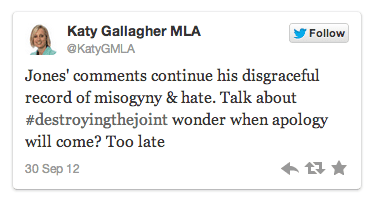A big weekend of election results around the country has seen the ACT retain its crown as having the highest proportion of women in any parliament in the country — although it has slipped somewhat.
A state-by-state analysis for Women’s Agenda sister publication Crikey has found that Victoria and the Northern Territory also rank relatively highly for female representation in their lower houses, while Western Australia (where just 7% of lower house Coalition MPs are women) comes in last. Looking at MPs from the two major parties across the country’s lower houses (and federal Parliament), about a quarter of MPs are women.
Before the recent ACT 2012 election, women made up 41% of the unicameral Legislative Assembly. That’s now 35%. This slide in women’s representation is largely due to female Greens MLAs (Meredith Hunter, Amanda Bresnan and Caroline Le Couteur) being replaced by two Liberal Party men (Andrew Wall and Steve Doszpot) and Labor’s Yvette Berry. The make-up of the new ACT Assembly repeats a long-term trend across the nation, with Labor significantly ahead of the Coalition in its representation of women in parliament. Labor women in the ACT have now achieved parity for the first time; with a 50-50 split of seats between the s-xes:
|
Political Party |
Male MPs |
Female MPs |
%F |
|
ALP |
4 |
4 |
50% |
|
Canberra Liberal |
6 |
2 |
33% |
|
Greens |
1 |
0 |
|
|
Total |
11 |
6 |
35% |
Gender divide: makeup of the new ACT Assembly
There’s nothing new about these results; the Coalition has long trailed behind Labor in the proportion of women MPs in its ranks. But until the recent gender wars sparked by the treatment of Prime Minister Julia Gillard, these statistics were not generally well-covered in the press. Now, with Essential Media revealing gender-fault lines among voters at a federal level, and the PM’s approval rating improved by five points following her misogyny speech to Parliament, there is little doubt that how the major parties represent women is more significant. These tables express the percentage of women MPs in parliaments as a comparison between the two major parties: Below are two tables expressing the percentage of women MP’s in Australian Parliaments as a comparison between the major parties.
Two-Party Comparison in Australian Parliaments by Percentage of Females (%F)
Lower House
|
Political Party |
Cth %F |
NSW %F |
VIC %F |
Qld %F |
WA %F |
SA %F |
Tas %F |
ACT %F |
NT %F |
Totals %F |
|
ALP |
32.4 |
40.0 |
44.2 |
57.1 |
23.1 |
42.3 |
30.0 |
50.0 |
37.5 |
36.9 |
|
Coalition (LP; Nats; CLP) |
18.3 |
15.9 |
22.2 |
16.7 |
7.1 |
16.7 |
20.9 |
33.3 |
31.3 |
17.9 |
|
Total % F |
24.7 |
21.5 |
33.0 |
20.2 |
18.6 |
29.8 |
24.0 |
35.2 |
32.0 |
25.3 |
Upper House
|
Political Party |
Cth %F |
NSW %F |
VIC %F |
Qld %F |
WA %F |
SA %F |
Tas %F |
ACT %F |
NT %F |
Totals |
|
ALP |
48.4 |
35.7 |
31.3 |
63.6 |
25.0 |
0 |
41.0
|
|||
|
Coalition |
23.5 |
31.5 |
28.6 |
33.3 |
28.6 |
100 |
29.1
|
|||
|
Total % F |
38.2 |
31.0 |
32.5 |
47.2 |
31.8 |
40 |
36.8 |
|
Political Parties |
Total %F Australian Parliaments |
|
ALP |
38.0
|
|
Coalition |
20.5 |
If numbers count in the gender war, the Coalition is now at a considerable disadvantage in every parliament in the country. Labor has double the percentage of women in lower houses. It also has the higher number of women in upper houses.
At the 2008 WA election, the Coalition elected only two women out of 28 MPs to the lower house, delivering women the lowest representation in an assembly across the country; just 18.6%. Although the WA figures improve in the upper house to 47.2%, this is largely due to the combination of Labor and Greens MPs (both elected more women than men to the upper house; 63.6% and 75% respectively).
In Queensland, where there is no upper house, the election of the Liberal-National Party not only wiped out Labor, but the majority of women MPs. Newman’s sweeping victory in March reduced the number of women in the Queensland Parliament from 36% to 20.2%. Under Bligh, Labor women neared parity — 49%. Liberal-National women make up only 17% of Newman’s government.
Last week Coalition Senator Concetta Fierravanti-Wells criticised Labor party “quota girls”, asserting that Coalition women didn’t need affirmative action to win seats. But this is not a position shared by all women in her ranks. Within days of the Margie Abbott blitzkrieg, Liberal Senator for Queensland Sue Boyce criticised her party for failing to elect more women, calling on the party to institute a target of 30% women’s representation within 10 years as a way of addressing the “perceived unpopularity of the Coalition amongst women voters”.
Although Labor has had more women representatives for years, it is only now starting to understand and make use of its advantage electorally. ACT Labor leader Katy Gallagher entered the fray early on the Alan Jones story, tweeting:
Gallagher was of the few Labor MP’s to publicly back #destroythejoint, and she co-hosted a Women in Parliament breakfast with Gillard.
Women’s representation in parliaments can no longer be dismissed by either party as a marginal issue in election campaigns, just as women’s concerns can no longer be diminished to a discussion of reproductive rights.



